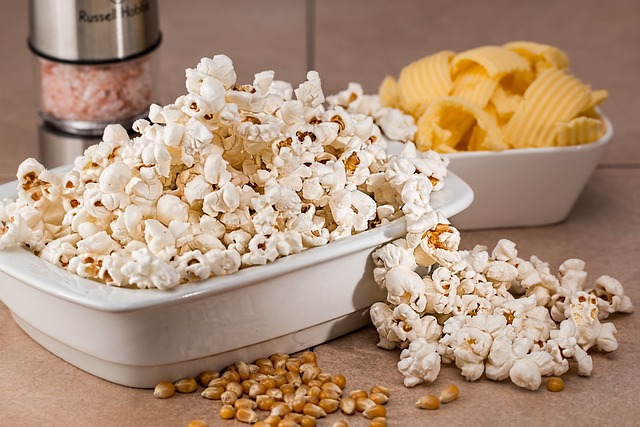
The inventor of Popcorn is usually attributed to Charles Cretors of Chicago, who is considered the father of modern-day popcorn. In 1885, Cretors created a mobile popcorn cart, which he used to sell popcorn outside his shop in Chicago. He was granted a vendor’s license and began selling popcorn in December of the same year.
Popcorn is a type of corn kernel that expands and puffs up when it’s heated. The hull of the popcorn kernel contains the seed’s hard, starchy shell endosperm with 14-20% moisture. When heated, this moisture turns into steam, building pressure within the kernel until the hull ruptures. This process allows the kernel to expand to 20-50 times its original size before cooling. Certain strains of corn, specifically Zea mays everta, are cultivated for popping purposes. Popcorn is one of six major types of corn, which includes dent corn, flint corn, pod corn, flour corn, and sweet corn. Let’s get a specific answer on the inventor of Popcorn now!

Who is the inventor of Popcorn?
Talking about the Inventor of Popcorn, according to Popcorn.org, archaeologists have found evidence of popcorn in various regions of Mesoamerica, South America, and North America. History.com states that the Iroquois people were observed popping corn kernels in pottery jars heated near the Great Lakes region during the 1600s.
Corn was first domesticated in Mexico around 10,000 years ago. Popcorn has been known for thousands of years and fossil evidence from Peru suggests that it was popped as early as 4,700 BC. In the 19th century, people used to pop kernels by hand on stove tops and sold them under names like Pearls or Nonpareil on the East Coast of the United States. The term “popped corn” was first used in John Russell Bartlett’s 1848 Dictionary of Americanisms. Popcorn was used as an ingredient in Cracker Jack and was popped by hand in the early years of the product.
When was popcorn invented?
Now that we know the Inventor of Popcorn, let’s find out when was popcorn invented. Popcorn has an interesting backstory. Corn has been a cultivated crop for about 9,000 years. The first evidence of popcorn was found in Peru in 2012. Archaeologists discovered 6,700-year-old corn cobs with puffed kernels. In the mid-1800s, the mould-board plow invention brought a significant change in industrial crop cultivation, leading to widespread corn planting across the United States, particularly in the Midwest. At the same time, homemade popcorn was becoming increasingly popular as a snack and holiday ornament.
History Of Popcorn & Inventor of Popcorn
During the Great Depression, popcorn gained popularity due to its affordability at 5-10 cents per bag. While other businesses were struggling, popcorn thrived and helped struggling farmers, including the Redenbacher family, earn income. During World War II, sugar rations led to a decrease in candy production, and Americans turned to popcorn as a substitute, consuming three times as much as before. Initially, theater owners were not pleased with the snack’s popularity, as they believed it distracted from the films. However, theater owner Glen W. Dickinson Sr. installed popcorn machines in the lobbies of his theaters and found that popcorn was more profitable than tickets. He purchased popcorn farms and kept ticket prices low, leading to a successful venture. The rise of television in the 1940s caused a decline in popcorn consumption as theater attendance decreased. However, the Popcorn Institute promoted popcorn consumption at home, bringing it back to previous levels.
Orville Redenbacher’s popcorn brand was introduced to the market in 1970. General Mills obtained the first patent for a microwave oven popcorn bag in 1981, which led to a significant increase in popcorn consumption by tens of thousands of pounds. Six localities in the Midwest, namely Ridgway, Valparaiso, Van Buren, Schaller, Marion, and North Loup, claim to be the Popcorn Capital of the World. According to USDA, Nebraska, and Indiana mainly produce popcorn-specific corn, with Texas increasingly joining the production. Popcorn became the official state snack food of Illinois as a result of an elementary school project.

When Did Popcorn Become America’s Most Beloved Cinema Snack?
Popcorn’s popularity was once limited to festivals, fairs, and sports events. However, the Golden Age of Hollywood helped to change that. As movies and movie-going grew in popularity during the 1920s and ’30s, with up to 85 million people attending weekly during the Great Depression, popcorn became a staple snack. Despite this, most movie theaters initially banned the snack in an attempt to maintain an air of sophistication. This information was reported in Smithsonian Magazine.
During the Great Depression, movie theater operators discovered that selling bags of popcorn for 5 or 10 cents each could help them financially thrive. Popcorn became an affordable luxury that Americans could enjoy even during tough times. Glen W. Dickinson Sr., a movie operator, installed popcorn machines in his theaters’ lobbies in 1938, and other vendors followed suit. This move proved to be successful, and theaters across the country started relying on concession sales as their primary source of profit.
Popcorn has a rich history, and its iconic flavor is familiar to people of all generations.
How is Popcorn Made Today?
Popcorn has remained unchanged in its fundamental preparation techniques for over 9,000 years. Essentially, the process involves heating maize kernels until they burst, resulting in a delightful and fluffy snack. Popcorn can be prepared using different methods such as air poppers, popcorn machines, or pots containing oil. Additionally, there is a range of flavors that can be added to popcorn to tailor it to individual preferences, including butter, cheese, caramel, and chocolate. This versatility makes popcorn an adaptable snack that can be enjoyed in numerous ways.
